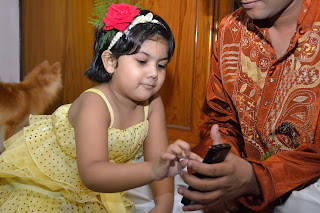Mobile Phones To Deliver Education To Children In Developing Countries
General Word:
Cell phones are a popular option for projects aimed at helping disadvantaged students because these devices, compared to equipment such as laptops, are less expensive and more likely to already be present in the environment. They may also encourage the untapped potential of inter-generational learning as a new and engaging “scaffold” for adult/child interaction. For example, beginning in early childhood, mobile technologies can have unique potential to help low-income children learn essential literacy skills through interactions with their caregivers.
Description:
The program provided information to parents who were busy and “on the go.” Instead of having to find the time to log into a Website or attend a meeting, parents would receive messages on their own cell phones. Tips revolved around everyday literacy activities the parent could engage in with the child (e.g., while waiting in line at the grocery store or sitting at home in the living room).
The study found positive outcomes in parents’ ability to scaffold aspects of their children’s learning, children’s mastery of the functionality of the devices, increased knowledge from pre- to post-intervention, and increased enthusiasm among parents and children. Another important effort was the Making Playful Learning Visible project, which used mobile devices to aid low-income parents in becoming better mentors to and observers of their preschool children (Thomas and Bradburne, 2005). Citing research that confirms that early childhood learning is often embedded in play and spontaneous play-like activities (Hughes, 1999; Jarrell, 1998; Moyles, 1989; Singer and Singer, 1992).
The study focused on having parents observe their children at play, to make parents aware of
(1) how their children first encounter and begin writing,
(2) how movement is an important aspect of a young child’s life, and
(3) how repeated patterns are evident in children’s play.
Each parent was equipped with a Nokia 6630 to record the child’s progress at any moment. Parents themselves reported being more aware of the skills being learned and demonstrated during playtime as well as how participation in their child’s play can facilitate that learning. They were also more eager to share with and learn from other parents. The use of mobile technology was essential for success because parents reported that the phone was portable; allowed for spontaneous behavior to be documented; was easy to operate; had an excellent camera and video-editing feature; and helped them feel comfortable with new technology, since it approximated devices that they already used and improved existing skills.
It should be noted that the technological aspects were only a part of a larger system, which included in-person meetings, written journal entries, and parent/child interactions. Mobile phones have also been tapped to deliver education to children in developing countries that do not have an extensive communications infrastructure. Perhaps the most groundbreaking mobile-learning initiatives are happening in underdeveloped areas of Africa, where access to personal computers is limited but mobile devices are inexpensive and increasingly available (Aderinoye, Ojokheta, and Olojede, 2007). Half the existing telecommunications lines there are concentrated in capital cities, accounting for only 10% of the continent, and the largest cities of several countries have more than 70% of the total telecommunications lines (Brown 2004; Aderinoye, Ojokheta, and Olojede, 2007). Mobile phones, which have penetrated even remote areas, have the ability to offset these disproportional numbers between cities and rural areas.
The Nigerian National Council for Nomadic Education, founded in 1989, seeks to improve the educational opportunities for those primary school-age children lacking in adequate shelter, food, and health care. The Council, dissatisfied with the results of traditional distance education methods, recently began integrating mobile technologies into its curricula. Preliminary reports indicate increased literacy among target populations and support the suitability of mobile technologies for nomadic lifestyles (Aderinoye, Ojokheta, and Olojede, 2007). The MOBI Project of South Africa delivers mathematics content to students and provides mobile access to tutors (Matthee and Liebenberg, 2007), and the School Empowerment Program of Kenya is especially interesting in that it uses mobile technologies to remotely provide primary school teachers in rural and urban areas with training, support, and materials (Traxler, 2005).
One of the most promising mobile programs operating in developing areas of the world is Freedom HIV/AIDS, an initiative to use mobile phone games to educate people about HIV/AIDS. In 2005, the Delhi-based company ZMQ Software Systems released four mobile games to promote HIV/AIDS awareness through India’s largest mobile operator, Reliance Infocomm. The games were initially launched on 9 million handsets and later were scaled up to 40 million handsets. Mobile operators promoted the games through regular text messages, offering the games free for download, and in a span of 14 months, 10.4 million game sessions were recorded. The games were specially designed for low-end black-and-white mobile devices so as to reach grassroots communities, although they could also be played on high-end devices. ZMQ later launched the Africa Reach Program to reach more Africans by creating games and applications in local languages, thereby targeting overlooked populations.
Reaching students outside the classroom Mobile technologies can empower kids to explore a whole range of environments, from the outdoors to public spaces, as well as to connect the skills and content learned outside the classroom with new knowledge and perspectives gained in school. In this way, mobile technologies may be a key element of a needed 360-degree approach to learning. Mobile technologies can purposefully extend classroom learning to include out-of-class activities such as homework and field trips (Sharples, 2005) that allow for sustained teacher contact and support. In science pedagogy, the ability to move from the classroom to the world is particularly advantageous, since fieldwork and real-world data collection are so important to the work conducted by professional scientists (Scanlon, Jones, and Waycott, 2005).
Likewise, in language classrooms, handheld devices allow students to learn vocabulary while doing extracurricular activities and to capture real-life examples of unfamiliar words and phrases (Thornton and Houser, 2005). The physical classroom no longer becomes the sole locus of formal learning. In addition, with mobile technology, students can bring classroom materials with them and remain in contact with their teachers while at a remote location. Three main European projects that investigated wireless technologies in education—M-learning, DfES/Becta PDA Project, and MOBIlearn—concluded that mobile technologies allowed for enhanced learning on field trips (Attewell, 2005; O’Malley et al., 2003; Traxler and Kukulska-Hulme, 2005). In addition, researchers have noted increased student motivation, collaboration, and attention as a direct result of the inclusion of these mobile components (Miettunen and Mattila, 2007; Hartnell-Young, 2005; Hartnell-Young, 2008; Johnson et al., 2008).
Conclusion:
There is also an increased number of games specifically designed for mobile devices that require continuous movement from place to place and have the benefit of creating an authentic, hands-on learner experience (Dembo, 2006; Games Atelier, 2007). The majority of such applications involve museums, though some incorporate an entire town or city.












No comments:
Post a Comment